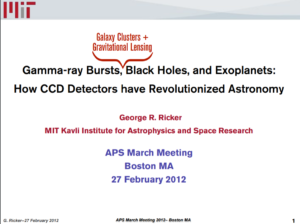
Dr. George Ricker, Senior Research Scientist in MIT’s Kavli Institute for Astrophysics and Space Research, described the work of four of his graduate students. Detector development was central to the Ph. D. education of each, opened new frontiers, and led to a career and leadership in astronomy or space science.
Gamma-ray Bursts, Black Holes, and Exoplanets: How CCD Detectors have Revolutionized Astronomy
Author: George Ricker (Massachusetts Institute of Technology)
I will tell the story of my research group’s role in the development of astronomical charge-coupled detectors (CCDs) by relating the contributions of four MIT research students to projects which we have undertaken together over the past three decades. These projects have empowered observations extending over four decades of the electromagnetic spectrum, enabling discoveries ranging from gamma-ray burst emitting collapsars at cosmological distances, to accretion-driven black holes in the Galaxy, and to exoplanets in the solar neighborhood. This story will illustrate the key contributions which student researchers can make when a novel detector technology arrives on the scene. Finally, I will also describe some of the ways in which their early education in these possibilities has impacted my students’ future careers as astronomers and experimental physicists. — SLIDES
